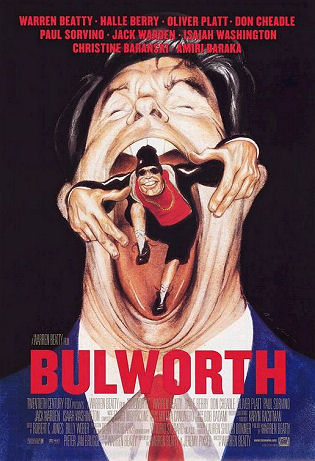Rollover
I don’t want to say too much about Wolfgang Petersen’s Poseidon (Warner Bros., 5.12) because this isn’t a regular “review” or anything. Maybe if I begin by talking about the 1972 Ronald Neame film (a piece of big-budget schlock that was a major blockbuster in its day), it’ll seem like less of one.
The original The Poseidon Adventure, which I just saw on a new double-disc DVD, was a bit rough to begin with — cornball characters, lumpy dialogue, cheesy special effects — and time has not helped. It’s almost painful by today’s standards — a movie with a two or three strands of silver hair growing out of its ear and some wretched acting here and there, and that putrid theme song, “(There’s Got To Be) A Morning After.”

Gene Hackman’s combover hair style looks awfully weird, and Shelley Winters’ fat Molly Goldberg character is enough to make anyone groan. And the effects…forget about it. The opening credits are laid over a slow-motion shot of what looks like a three-foot model of the S.S. Poseidon cruising along in a studio tank.
Poseidon, which I saw Tuesday afternoon, is a much better film. I didn’t see the reviled TV-movie version that aired last November with Steve Gutenberg, but it’s probably a lot better than that also. Lots of excitement. Much better special effects all around. No bullshit sentiment or emotional fat lathered onto the story or the characters. Streamlined, adrenalized…at least one action-suspense sequence that is arguably classic. And only 100 minutes long vs. 117 minutes for the ’72 version.
< ?php include ('/home/hollyw9/public_html/wired'); ?>
It moves right along and kicks ass according to the rules of the game it’s playing. There is no basis for any substantive quarrel with any movie that does what it sets out to do, and this $150 million action thriller does that. It is what it is, take it or leave it, etc.
Less than fifteen minutes of character set-up and along comes the rogue wave. (I adore the fact that there’s no explanation or set-up except for everyone’s memory of the Southeast Asian tsunami.) And then it’s just a matter of staying with a small team of survivors (Josh Lucas, Kurt Russell, Richard Dreyfuss, Emmy Rossum, Jacinda Barrett, etc.) trying to climb down — up — to the ship’s hull to find a way out.
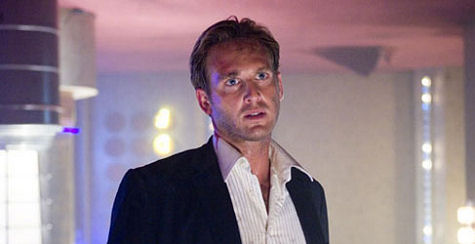
Josh Lucas in Wolfgang Peterseon’s Poseidon (Warner Bros., 5.12)
What could be simpler? And no one, thank fortune, talks about their fears or longings or what’s wrong with their life, or how much they love or miss their wife, husband or kids. I felt truly delighted — I think I can say I was overjoyed — that Petersen and screenwriter Mark Protosevitch made the decision not to go in this direction.
Remember those desperate survival sequences in Titanic with Leonardo DiCaprio and Kate Winslet sloshing and swimming around and trying not to drown in the lower areas of the ship as the water gets higher and higher? It’s all like that but cranked up a bit more.
In fact, speaking of Titanic, one of the things intensifying the suspense in Petersen’s film is the fact that this new super-sized S.S. Poseidon is sinking (which wasn’t a factor in the ’72 film).
And I love the eye-filling CGI aerial shot of the big ship that opens the film. It swoops around and goes on for a long while, and I think Petersen did this in part so people will remember that a similar shot in Titanic, released eight and a half years ago, was much cruder…cartoony even.
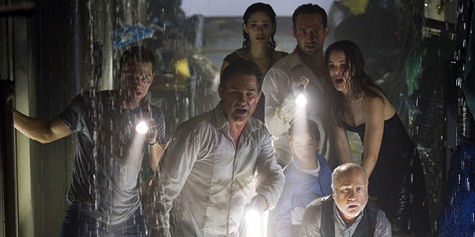
I’ve probably gone on too long so I’ll wrap it up by saying if Warner Bros. doesn’t give it a big nationwide sneak this weekend (which they apparently aren’t planning on) they’re making a big mistake. They’ve got a quality package — they should let people see it and react. I only know that the TV ads and trailers haven’t sold it sufficiently thus far.
For the first time ever, by the way, I found myself warming to Josh Lucas, although his character — a selfish professional gambler — isn’t exactly “likable.” What got me is the ferocious life-force energy that Lucas exudes once the crawling-through- the-ship action begins. He’s an unstopppable survivalist.
I said to myself early on, “I’m with this guy…I’d want him with me if I were in a tough spot.” I’ve never felt much liking for Lucas before, so this is (somewhat) significant.
Rocket Man
The great critic F.X. Feeney told me the other day about a short film about 9/11 called The Falling Man, and that it was about to be shown at the Tribeca Film Festival. With Paul Greengrass’s United 93 set to open the festival on Tuesday, 4.25, I thought right away, whoa…I should see this. So I did on Friday afternoon (4.21), and I went “whoa” again.
Directed and written by Kevin Ackerman, The Falling Man is an M. Night Shyama- lan-styled spooker about a real-life guy who bought it on 9/11…probably the best known of the 200-something people who jumped from the burning towers because his picture was in the New York Times and everywhere else the next day.
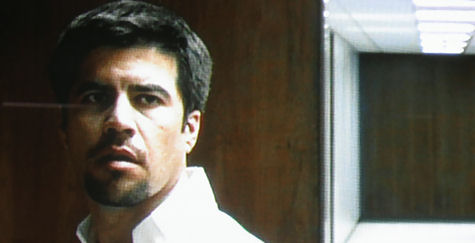
Rick Ojeda as Windows on the World employee Jon Briley in Kevin Ackerman’s The Falling Man
Taken by AP veteran Richard Drew, it showed a tallish, goateed, light-skinned African-American guy, falling upside down in a white shirt, orange T-shirt, black pants and black high-tops, dropping at close to 150 mph in a perfectly vertical posture, not flailing (in this particular shot, at least) and seemingly resigned to his fate, or at least not desperately fighting it.
Part flashback and part flash-forward, The Falling Man is a trippy life-death riff, and well worth seeing.
It’s about a waiter (Rick Ojeda) working at Windows on the World, the restaurant on the top floor of the north tower, who’s sent down to the 103rd floor to the offices of Cantor Fitzgerald to deliver some food, but he can’t find anyone. Vacant. Empty desks, papers on the floor, silhouettes behind smoked glass but no one there. He’s Earl Holliman in “Where Is Everybody?”, anxious and starting to freak out.
Then he runs into a woman with gray skin who looks like a zombie out of George Romero’s Dawn of the Dead, and it hits you after a second or two that her skin isn’t zombie-gray but ash-gray. And then spookier things happen, all leading to a realization.
It’s September 11, 2001, of course. Sometime around 9:41 am…or in some nether place made of memory, premonition, and flashbacks thrown together. But most of it is happening in the mind of the waiter, who existed and was named, in all likeli- hood, Jon Briley.

There was natural curiosity in the public mind about who he was because of the photo, but Briley’s identity was in question for the better part of two years, partly because his body was destroyed, partly because the photo was pulled from circulation, and partly because his father and others in his family didn’t want to know or deal with it.
But then Esquire‘s Tom Junod wrote a piece about the photo called “The Falling Man“, which ran in the September ’03 issue (with Colin Farrell on the cover). Junod came to the conclusion it was probably Briley, and then a British documentary, also called The Falling Man, ran last month and concluded it was probably Briley too. The makers based their findings on testimony from a top chef who worked at Windows on the World named Michael Lomonaco as well as Briley’s older sister, Gwendolyn.
Then came a filmmaking contest sponsored by Esquire a few months later in which contestants had to make a short film based on one of a selection of short stories and features that had appeared in the magazine.
Ackerman, who had recently directed a low-budget noir called Lonely Place, decided to make a film about Junod’s piece. The idea has come to him in a flash during a visit to the downtown LA set of In Good Company, when he realized that a suite of offices in a tall building he was standing in could double for the offices of Cantor Fitzgerald.
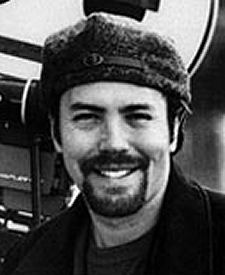
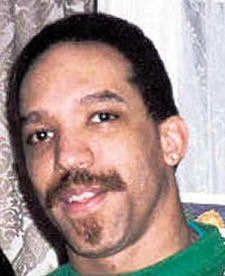
Falling Man director-writer Kevin Ackerman; 9/11 victim Jon Briley
Ackerman shot the film in April 2004 over a couple of days, just before the contest deadline. It cost him about $6000 at the end of the day. Ojeda and Ron Sanford produced it with him. It was shot by John Hale and Steve Smith and edited by David Miller.
Although Esquire‘s contest specified that the shorts be no longer than five minutes, Ackerman’s ran eight minutes. It meant he couldn’t win the prize money (a piddly $2500) but the judges — among them director Alexander Payne (Sideways), former Paramount Classics chief Ruth Vitale and Endeavor agent (and Paramount Clas- sics honcho-to-be) John Lesher — saw it anyway, and were impressed.
By September 2004 Ackerman had moved on to other things, but Payne got in touch that month and said he was really taken with The Falling Man (“This film is fantastic”) and urged Ackerman to shoot additional footage in order to round it out and fulfill his vision.
So Ackerman did that. He added some new footage (a sequence with a 9/11 memory wall was a significant addition, I can say) and finished the extra lensing in September 2005. Naturally, he felt the Tribeca Film Festival was the best place to premiere it, especially given a stated interest by festival honcho Robert De Niro in wanting to see 9/11-themed films submitted. De Niro saw a rough cut of The Fall- ing Man last December and it was accepted soon after.
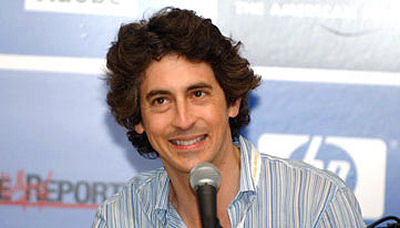
Falling Man admirer and supporter Alexander Payne
Ackerman just finished the final, fussed-over version — transferred to 35mm film, in anamorphic scope — earlier this week. He flew to New York this weekend with the print.
The Falling Man will have four showings during the festival — on Sunday, 4.30, 9 pm at the Museum of Jewish Heritage, on Tuesday, 5.2, 6 pm at Pace University’s Schimmel Center, on Wednesday, 5.3, 10 pm at AMC Loews Village VII, and on Friday, 5.5, 11 pm at Regal Cinemas Battery Park 5.
It’s not an absolute masterwork but it’s a very penetrating film, obviously because it draws on 9/11 emotions, but also because it adds a surreal, Twilight Zone-ish feel- ing to a familiar canvas, supplying a kind of fresh echo…producing a result that’s unnerving but on some level very “real.”
Ackerman can be reached via Tried & True Productions at 323.466.1602. His email is citizenack@aol.com.
Aroma, Sizzle, Steak
I used to love movie poster art, but there are so few today that pop through in any kind of sexy or distinctive way that the fun, for me, just isn’t there any more. Or not enough.
Take five or ten minutes and browse through this British website devoted to classic one-sheets, and you’ll see what I mean. (Make sure you check out the Saul Bass page.) A lot of them were standard primitive sells, but the better ones from the ’50s, ’60s and ’70s had flair, smarts, suggestiveness…a kind of art-gallery urbanity.

Movie posters that were hanging in Hollywood Museum on Thursday, 4.20…but are gone now because it was just a one-day, one-shot deal.
Many of today’s posters, of course, are geared to mall-heads. They get your attention but in a much more rudimentary way. Many of them are basically about emphasis over enticement, and always seem to use the primary colors, emotions and attitudes that are likely to appeal to younger, less educated viewers with shorter attention spans.
But I figured I’d go down to the Hollywood Museum anyway to check out the 2005 posters that have been submitted for the 2006 Hollywood Reporter Key Art Awards. The winners will collect their trophies at a big swanky ceremony held June 16 at the Kodak Theatre, with Kevin Nealon serving as m.c. (Click here for more info.)
I got there around 12:30 on Thursday, and ten minutes later I was almost ready to leave.
The first and second floors were stuffed to the gills with posters and standees for cinema primitivo — primarily big-budget action, horror, FX and teen-market crap. Precisely the kind of films I loathe. I read books, I’ve been to college and I’ve stood inside the Pantheon in Rome, and every poster and standee on those floors said, “C’mon, man…you’re a gorilla. You know you are. Here, have a banana.”
Then my hosts — Hollywood Reporter publicists Lynda Miller and Alisha Maines, and mPRm’s Shari Mesulam and Wendy Martino — took me to the third floor and finally…some good stuff! Posters with a semblance of art and finesse and sophis- tication.
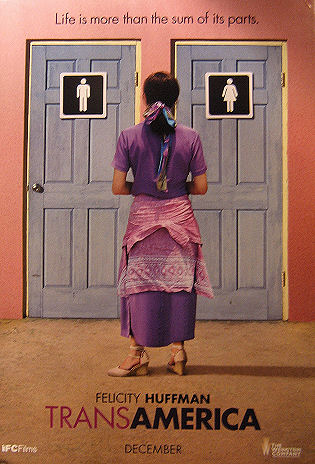
My choice for the best one-sheet is the one pictured above, for Transamerica. I’m also a fan of the one-sheets for Capote, Jarhead, Inside Deep Throat, et. al. But very few of them had that capturing-the-essence, vaguely highbrow approach. I mean, a few did.
The one-sheet for Warren Beatty’s Bulworth (1998) had that element, that way of compressing the soul or attitude of a film into a single chord.
I asked what percentage of the posters submited were from the indie sector and and big-studio distributors. An answer never came back, but Key Art Awards Coordinator Marc Romeo, who’s been facilitating the entry and judging process for six years, says that 70% of this year’s 1,423 entries received (in 29 categories) have been submitted by agencies and vendors and 30% were submitted by studios.
I happened to notice two posters hanging on a stairwell for a couple of broadly commercial films from the ’50s that no one wants to see these days, that aren’t on DVD and that I’ve either forgotten about or never heard of. One was All Hands on Deck, a 1961 Navy comedy with Pat Boone and Buddy Hackett, and You Can’t Run Away From It, a remake of It Happened One Night with Jack Lemmon and June Allyson.
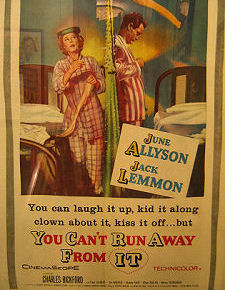
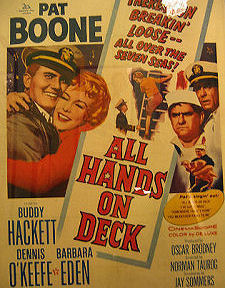
These movies may have been popular in their day but they’re dead now — unknown and unwatched by even the cultists. I mean, you could send a messenger with a basket of fruit, a bottle of champagne and a new DVD of All Hands on Deck to my door, and I really doubt if I’d watch it.
We all have ideas, I’m sure, about which films playing today are not only disposable by today’s standards but certain to be forgotten by history. Most of the films that have come out over the last couple of months belong in this category, February, March and early April releases being what they are. It’s a desert out there.
Anyway, my four hosts took me to Mel’s after our tour, and we all sat down and ordered the healthiest foods we could find on the menu. And then mPRm honcho Mark Pogachefsky dropped by to say hello, and then Hollywood Reporter ad sales exec Lynn Segal came in with friends for some lunch. And it was basically a nice visit.
But it would have been nicer if Saul Bass had been there.
